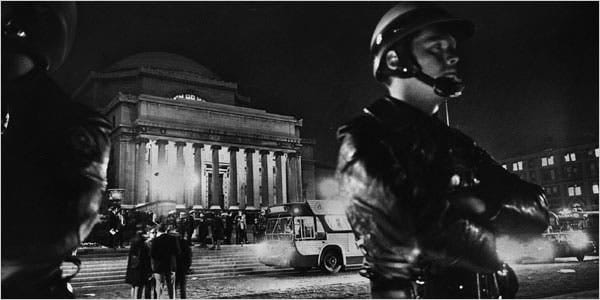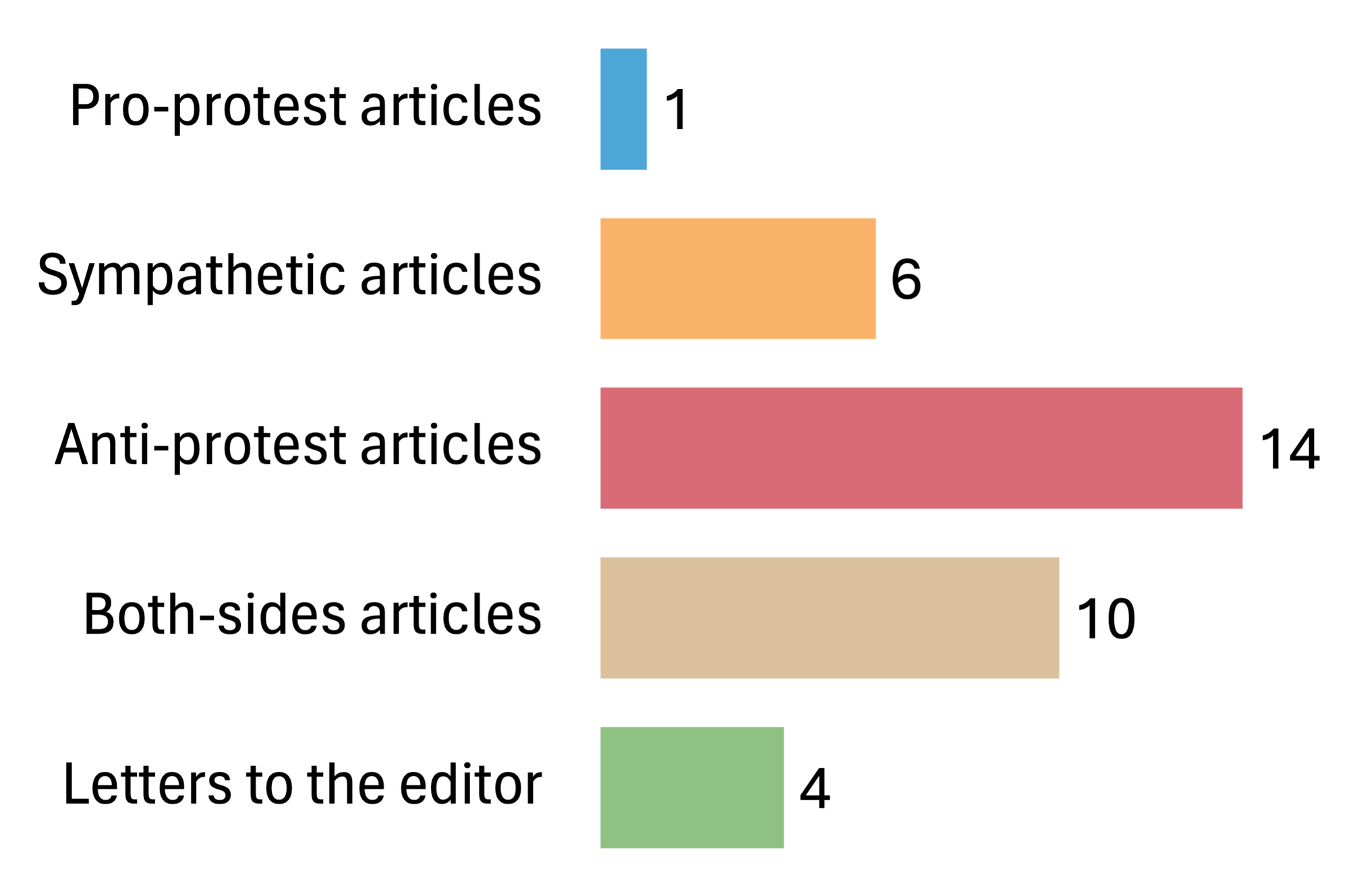Scapegoats

Last blog, we made fun of Ed Kilgore’s take on the 1968 vibes of everything right now, which was that the vibes are not very 1968 right now. That was published on April 18. We also noted that, on the same day, the NYPD arrested over 100 student protestors on Columbia University’s campus. You know where this is going.
Since then, columnists have directly compared the vibes of everything right now to the vibes of 1968 in the Washington Post, the New York Times, the Wall Street Journal, the Atlantic, the New Yorker, the Guardian, the Associated Press, CNN, NBC News, Fox News, Reuters, Politico, Bloomberg, USA Today, and probably more. I stopped Googling. It’s all un peu sur le nez if you ask me.
At some point, historical analogies become useless — dumb, even. So I’m officially halting further production of historical analogies. No more historical analogies until we figure out what the hell is going on.¹ For the foreseeable future, nothing has ever happened before. And I’m starting a petition to stock more historically significant years in the historically significant years aisle of the nationally-syndicated opinion columnists store.
Opinion columnists play an important role in our society. Without them, most headlines would not be very titillating, and we would probably click on them less. We would also probably be better at differentiating fact-based journalism from creative writing, which could lead to problematic rates of critical media literacy. For example, if leading news organizations didn’t intentionally intermingle salacious op-eds with evidentiary reporting as a reader engagement strategy, we might notice and care more when ostensibly objective journalism exhibited egregious biases. Luckily, at each of our nation’s venerable newspapers, opinion columnists are there to continuously undermine the public’s trust in traditional journalism, as they should.
The largest American newspaper by readership is the New York Times, which currently has about 10.5 million paid subscribers, according to the New York Times. It follows that the cream of the opinion columnist crop would likely end up creaming their crops at the Times opinion desk. The paper also just won the 2024 Pulitzer Prize in International Reporting for its coverage of Israel and Palestine since October 7. Logically, if we want to figure out what the hell is going on with the 1968 vibes of everything right now, we should start at the Times.
So I did that. I collected and read all of the relevant content produced by the opinion section of the Times since Columbia University’s Gaza Solidarity Encampment began, because this blog is a fundamentally self-flagellating project. And then I turned it into quantitative data.
How I did that
Columbia’s encampment sprung up in the early hours of April 17, 2024, so I aggregated Times opinion content from April 17 to May 8 — a three week period. You can see all the data for yourself, and read my “methodology,” at this link. The breakdown looks like this:
- From April 17 to May 8, the Times opinion desk published 54 articles related to Israel and Palestine. Note that this is only opinion content; it excludes the general reporting the Times published during this timeframe, which was far greater in volume.
- Of those 54 articles, 35 were related to campus protests or referenced them in a significant way. Most of the content was traditional opinion editorials, with a handful of audio transcripts, Q&As, and letters to the editor.
This was by no means the majority of the opinion desk’s work during the timeframe. On a single day alone, the Times might publish 10 or more pieces of opinion content spanning a variety of beats. However, we can reasonably conclude that the campus protests were an editorial priority for the Times during this timeframe, since one or more related articles was published on 15 out of the 21 days analyzed.
To make it interesting, I assigned a bias classification to each of the 35 campus protest articles. I was looking for opinions supportive of the protests, opposed to the protests, and maybe those that espouse a sympathetic adult-in-the-room middle ground. Many articles also attempted to evade explicit bias by employing a characteristic “both-sides” rhetorical strategy. This is the breakdown you actually care about:

Because I did not have the time, patience, sample size, inter-coder reliability, and STEM brainworms necessary to conduct a scientifically valid content analysis, the process of classifying each article was based on my own personal opinion. If you feel the need to question it, you are free to read each of the articles individually and formulate your own typology. Here’s what was going on in my head.
The opinion columnist store
Op-eds regularly tell their readers what to do or present a call to action. For an article to be classified as pro-protest, it would need to directly support or approve of the actions of student protestors. The only columnist who vaguely met this criteria is Lydia Polgreen.
But while reporting on the protests up close gave me insight into how unsettling some aspects of activism can be, it doesn’t mean the protesters’ actions are misguided. These young people seek a worthy cause: to end what may be the most brutal military operation for civilians in the 21st century.
Polgreen is also the only columnist who was actually physically present at Columbia University on the first day of arrests, which probably isn’t relevant.
Even the most protestor-positive of the opinion desk’s sympathetic articles contained concessions, qualifiers, and chiding admonition. Charles M. Blow thinks the vibes of everything right now are very 1968 — from a neutral, objective standpoint. Michelle Goldberg chastises Republicans for free-speech hypocrisy and Serge Schmemen concludes that “certainly there’s a lot to debate here.” Mara Gay gets sympathy points for the radical act of observing that none of Eric Adams’ claims regarding “outside agitators” on April 30 could be verified because journalists were unconstitutionally barred from the premises by the NYPD.
On the both-sides side of the vibes of everything right now, unbothered king Ross Douthat decided to complain, bipartisanly, about Columbia’s freshman reading list. Gail Collins and Bret Stephens do a bit where they pretend to podcast, which produced some memorable exchanges.
Bret: I think we tend to romanticize the protest movements of the 1960s while forgetting there was a lot of ugliness connected to them — including groups like the Weather Underground. I wonder if these protests will spawn something similar.
But getting back to the politics here …
Gail: OK, I will defer further argument, except for saying that the old protest movement created a generation of Americans who believed they were morally obliged to take a strong stand on political and social issues, including civil rights and women’s rights.
Bret: Very true. And I’d be more charitable toward the current protest movement if I ever saw them pause to condemn Hamas.
Gail: But moving on, I have to admit this whole scene is not gonna help Biden. Even though I appreciate his standing up for the right of free speech last week. The moderate or maybe-won’t-bother-to-vote electorate is not very likely to be rallied by it. On the other hand, I can’t see a lot of undecideds watching the protests and saying, “This has convinced me to vote for Donald Trump.”
Bret: I totally can.
Gail: Go on.
Me when I’m not mad and completely over it. But president of Wesleyan University Michael S. Roth wins the both-sides award of the blog all by himself, without feigning multiple personality disorder.
These days, the first thing that campus visitors may notice are protests over the war in Gaza. These will be attractive to some who see in them an admirable commitment to principle and off-putting to those who see evidence of groupthink or intimidation. Any campus should be a “safe enough space,” one free of harassment and intimidation, but not one where identities and beliefs are just reinforced. That’s why it’s profoundly disturbing to hear of Jewish students afraid to move about because of the threat of verbal and physical abuse. And that’s why it’s inspiring to see Muslim and Jewish students camped out together to protest a war they think is unjust.
The Times' expansive anti-protest op-ed library, which may soon be so prolific as to constitute a formal literary genre, is even more surreal. First, Nicholas Kristof condescends about how protestors can actually help Palestinians. Then, friend of the blog David Brooks opines about how the protestors can actually help Donald Trump.
These days, I think a lot about Donald Trump. When the monthly economic reports come out, I think: Will this help elect Donald Trump? And, I confess, I’ve started to ask myself the same question when I look at the current unrest on American college campuses over Israel and Gaza.²
In a courageous act of solidarity with his music humanities students, John McWhorter briefly makes it about race, and then calls Jews white. He also uses the terms “lusty chanting” and “crisp salute,” and employs the verb percuss in the past progressive tense. Later, he explains that this column was “one of the more polarizing things [he has] ever written” because it was misinterpreted in bad faith, clearly.
Here’s something: Name some significant civil rights victories between 1968 and the election of Barack Obama. It’s a lot harder than naming the victories up until that point.
Off the top of my head: Title IX (1972), Roe v. Wade (1973), the Equal Credit Opportunity Act (1974), Act Up (1987), The Americans with Disabilities Act (1990), Lawrence v. Texas (2003).

Bret Stephens is a self-identified Zionist because nation-states should function as geopolitical “insurance policies” for ethno-religious discrimination. His commentary on Ivy League antisemitism sagely reminds us that, if we want to predict the verdict of history, we should look to the example of “donors, alumni, and prospective students."³ And Charles M. Blow returns with Here’s Why That’s Bad For Biden.
Deep in the dark holes and damp crevices of our boolean search terms, you’ll stumble upon the secret goldmine of implicit institutional bias shrouded in plausible deniability: Letters to the Editor. On May 2, the Times published a not-opinion story about the face coverings that some protestors use to conceal their identities from journalists, administrators, and police. On May 7, the Times opinion desk published three reader responses to the story.
The first letter is written by “a former activist with a proud résumé of progressive civil disobedience and protest from the 1970s through the 1990s,” who argues that wearing masks is “anathema to the concept of a free exchange of ideas that the modern postsecondary educational experience is supposed to be all about.” The second contends that 2024’s anti-war protestors should not be compared to 1968’s anti-war protestors because 1968’s anti-war protestors were protesting “an unjust war [which] threatened to take our lives.” The third writes …
There is no courage in hiding behind masks as many of the recent protesters have done. There is no bravery in demanding that there be no punishment for breaking the law or violating campus policies and causing many others to feel intimidated or uneasy, as so many of the recent protesters have asked for in their “demands.”
There are three possible explanations of this phenomenon:
- As a demographic, readers of the New York Times are overwhelmingly likely to be offended by college students’ use of keffiyehs and other face coverings in the context of political demonstrations.
- The Times’ editorial board felt the morality of face coverings was an issue of such substantial public concern that it warranted publishing three separate reader letters with virtually identical opinions and stakeholders about it.
- Both.
Regardless, the vibes are boomer doesn’t understand internet privacy at best, racist at worst. And the downstream effect is things like this.
Why do I GAF
You don’t really need to, except insofar as the New York Times is where lots of very important people get their information and talking points. My guess is that the Times opinion section is currently fairly representative of the acceptable spectrum of opinions that one can publicly voice and still keep a job with a salary larger than $250k.
There’s a website slash activist group called New York War Crimes that has a much more sophisticated analysis of the Times’ reporting bias from back in March. You can read it yourself. If they don’t mind, I’m just going to pull a few charts.
To be obnoxiously clear: antisemitism is real and bad and deadly, and it is a good thing to care about the lives of Israeli citizens and Jewish college students. Etc.
I just think it’s interesting how
If you already read this far, you clearly had nothing better to do, so feel free to waste more of your time catching up on links (Palestine ones).
- The adults in the room • Columbia Journalism Review
- The are insecure for a reason • Defector
- Columbia University has a doxing problem • The Verge
- Now The Students Are “Terrorists” • Forever Wars
- Media coverage of campus protests tends to focus on the spectacle rather than the substance • Nieman Lab
- Lawmakers Admit They Want to Ban TikTok Over Pro-Palestinian Content • Rolling Stone
- Strapped down, blindfolded, held in diapers: Israeli whistleblowers detail abuse of Palestinians in shadowy detention center • CNN
- Al Jazeera office raided as Israel takes channel off air • BBC
- Why impact of Israel-Gaza war has become harder to document • Committee to Protect Journalists
Tomorrow is Nakba Day. I’m hoping to not write about Palestine next blog. Maybe some funny things will happen. Stay safe. TTYL.
- Topical throwback
- These days, I think a lot about your mom. When the monthly economic reports come out, I think: Will this help elect your mom? And, I confess, I’ve started to ask myself the same question when I look at the current unrest on American college campuses over Israel and Gaza.
- I’m still unclear why anyone thought the Ivy League of all places was a safe space from antisemitism.




